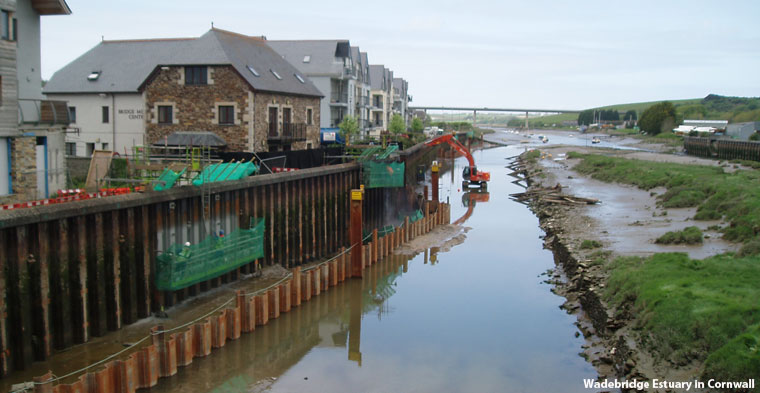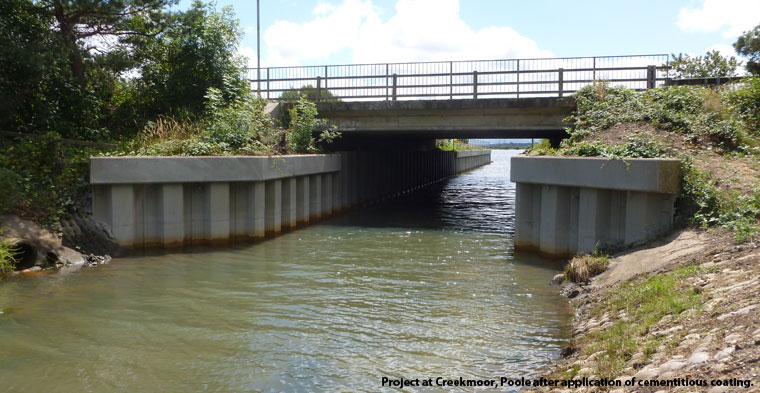
Although protective coatings are used as the most common means of controlling and inhibiting corrosion on marine structures, difficult working conditions in tidal environments will frequently lead to a reduction in effectiveness over the longer term. There is often limited access to marine structures, work must be completed within tidal windows and the environmental conditions can change in an instant. Fog can suddenly appear, the wind can prove ferocious and salt spray can make working conditions highly challenging. Chris Lloyd and Graham James of Flexcrete Technologies report.
Structural steel is the material of choice in the vast majority of structures in coastal and offshore locations due its combination of durability, ease of fabrication and ability to provide a relatively cost effective solution. However, in these harsh environments, steel corrosion is more prone to occur than of inland waters primarily due to the following factors:
- Galvanic cell formation whereby anodes and cathodes are formed between different metals or on the same metal due to varying conditions such as differential aeration or salt concentration in water
- Erosion of the corrosion by-products by wave action, impact from floating solids or cyclic deflection under load, causing quicker regeneration of rust
- Inadequacies of traditional anti-corrosion coatings exacerbated by a lack of planned preventative inspection and/or maintenance by owners
- Microbiological activity around the low water zone resulting in a particularly virulent form of concentrated corrosion that has become known as accelerated low water corrosion (ALWC)
Traditional resin coatings used on steel structures require optimum levels of surface preparation including removal of all contaminants and corrosion by-products back to bright metal and the absence of residual chlorides and surface moisture. However, realistically this cannot generally be achieved between tides without resorting to expensive coffer or limpet dams.
Over the past 30 years major technical advances in cementitious coating technology have allowed extended service-life solutions to be implemented as the preferred approach to sustainable development. This approach is valid for both steel and reinforced concrete marine structures, which are either reaching the end of the design life or which have suffered from premature failure.
The latest generation of cementitious coatings will overcome many of the limitations of resin systems and can be applied to damp substrates, achieving bond when only surface rusting has been removed. They are particularly tolerant to residual surfaces chlorides due to their ability, like concrete, to passivate and protect the surface of the steel. Offering high resistance to washout they withstand immersion as little as 60 minutes after placing. The high build application and rapid cure makes them less susceptible to damage, especially during their early life. If damage should occur during the long life of the coating, they show excellent resistance to rust creep, making the reinstatement a simple task.
Furthermore, as water-based systems, the environmental credentials are attractive, posing minimal risk in application, with all equipment being washed in water after use. ALWC is a specific form of microbiological corrosion, which can occur on sheet piling and other marine structures at or around the low water level, hence it often goes unnoticed. Unheard of in the UK until the 1990s, it is a phenomenon which has been described as a ‘steel-eating bug epidemic’ and is characterised by localised areas of soft orange corrosion products, overlaying a black organic sludge containing colonies of several types of bacteria. It is a concern to many port authorities and engineers worldwide as it can pose unexpected engineering and financial challenges.
The problem is not just associated with salt water, it has also been found on structures exposed to fresh water. The most economical solution is to apply a high performance coating at an early stage, thus maximising the design life and avoiding the risk of catastrophic, sudden failure with all the associated expense of structural repairs, lost business and risks to health and safety. High performance cementitious coatings offer an effective defence strategy to ALWC as they cure to form a dense coating with high levels of protection from water, oxygen and chloride ion penetration, as well as resisting the hydrogen sulfide formed by the sulfate-reducing bacteria.
How Cementitious Coatings Have Repaired and Protected Structures from Corrosion
Cementitious coatings have a long and proven track record of treating concrete in coastal environments and in more recent years the benefits for steel structures have also become more evident. Both new and refurbishment projects have been carried out, proving the practicality and advantages of the coatings in practice.
For example, work has been undertaken on sheet steel pilings for the Environment Agency at Wadebridge Estuary in Cornwall. Straddling the River Camel on the north Cornish coast, the town of Wadebridge is the gateway to the picturesque Camel Trail. Steel sheet piles form a tidal defence on the south-west bank of the river for a 200m section running seawards from the bridge. The river experiences large tidal rises and as a result the steel was suffering from significant steel corrosion. The client required an anti-corrosion coating that could be applied without extensive and costly cofferdams.
Cemprotec E942, a waterborne, two-component, cement and epoxy modified polymer coating, was specified as it could be applied to damp substrates and be subjected to immersion just two hours after application. Furthermore, the contractor, Concrete Repairs Ltd, could prepare the steel by using high-pressure water to clean off the loose rust and barnacles, and leave it between tides as it was immaterial if there were chlorides or flash rust on the surface. Prior to the main coating application, the gap between the clutches was filled with Cemprotec Clutch Filler.
Standing water was removed before proceeding with the application of Cemprotec E942 in two 1mm coats during a single shift using a Graco G-Max II airless spray unit. By comparison, when conventional resin coatings are used, the substrate has to be dry and it is important that no chlorides are present. With E942, it is actually advantageous if the substrate is damp and it doesn’t matter if chlorides are in existence, as they become bound in and passivated by the silica fume and cement binder in the coating.
A long-term steel corrosion protection solution has also been provided for sheet piled walls in Holes Bay in Poole Harbour, said to be the largest natural harbour in Europe. Carried out on behalf of the Borough of Poole, the project involved the maintenance of a 480m² area of sheet piles situated in an inter-tidal stormwater culvert in the Poole suburb of Creekmoor and located within a coastal preservation site. The steel piling was showing extensive signs of corrosion, including severe rust staining, due to continued exposure to salt spray and cyclical tidal immersion. As the sheet piles are frequently submerged and are subject to tidal fluctuations, one of the concerns was seeking a remedial solution that could withstand early immersion during the refurbishment works. It was also important that the chosen repair and protection products could demonstrate excellent adhesion to the steel substrate in this constantly wet environment. The project was managed by Balfour Beatty and materials were applied by Coastal Preservation Services. Due to the presence of corrosion by-products, marine growth and other contaminants, it was important that thorough surface preparation was carried out and the sheet piling was cleaned by UHP blasting to a sound, contamination-free surface. Cemprotec Clutch Filler was then applied with a pointing gun to flush fill the
clutches and this was followed by a 2mm application of Cemprotec E942 using airless spray techniques. Both products could be rapidly applied, as the Clutch Filler only needs to stabilise before application of E942 and on marine sheet piling a 2mm application of E942 can be built up as a single coat to enable completion in just one shift.



